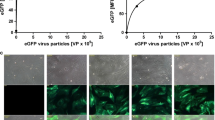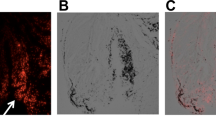Abstract
Objectives
To assess labelling efficiency of rabbit mesenchymal stem cells (MSCs) using the near-infrared dye 1,1’-dioctadecyl-3,3,3’,3’-tetramethylindotricarbocyanine iodide (DiR) and detection of labelled MSCs for osteochondral defect repair in a rabbit model using fluorescence molecular tomography–X-ray computed tomography (FMT-XCT).
Methods
MSCs were isolated from New Zealand White rabbits and labelled with DiR (1.25-20 μg/mL). Viability and induction of apoptosis were assessed by XTT- and Caspase-3/-7-testing. Chondrogenic potential was evaluated by measurement of glycosaminoglycans. Labelled cells and unlabeled controls (n = 3) underwent FMT-XCT imaging before and after chondrogenic differentiation. Osteochondral defects were created surgically in rabbit knees (n = 6). Unlabeled and labelled MSCs were implanted in fibrin-clots and imaged by FMT-XCT. Statistical analyses were performed using multiple regression models.
Results
DiR-labelling of MSCs resulted in a dose-dependent fluorescence signal on planar images in trans-illumination mode. No significant reduction in viability or induction of apoptosis was detected at concentrations below 10 μg DiR/mL (p > .05); the chondrogenic potential of MSCs was not affected (p > .05). FMT-XCT of labelled MSCs in osteochondral defects showed a significant signal of the transplant (p < .05) with additional high-resolution anatomical information about its osteochondral integration.
Conclusions
FMT-XCT allows for detection of stem cell implantation within osteochondral regeneration processes.
Key Points
• DiR-labelling of MSCs shows no toxic side effects or impairment of chondrogenesis.
• Fluorescence molecular tomography allows for detection of MSCs for osteochondral defect repair.
• FMT-XCT helps to improve evaluation of cell implantation and osteochondral regeneration processes.





Similar content being viewed by others
Abbreviations
- MSC:
-
mesenchymal stem cell
- DiR:
-
1,1’-dioctadecyl-3,3,3’,3’-tetramethylindotricarbocyanine iodide
- FMT-XCT:
-
fluorescence molecular tomography–X-ray computed tomography
- MR:
-
magnetic resonance
- DAPI:
-
4′,6-Diamidin-2-phenylindol
- GAG:
-
glycosaminoglycan
- TGF-β3:
-
transforming growth factor beta 3
References
Kon E, Delcogliano M, Filardo G et al (2010) Orderly osteochondral regeneration in a sheep model using a novel nano-composite multilayered biomaterial. J Orthop Res 28:116–124
Wakitani S, Nawata M, Tensho K, Okabe T, Machida H, Ohgushi H (2007) Repair of articular cartilage defects in the patello-femoral joint with autologous bone marrow mesenchymal cell transplantation: three case reports involving nine defects in five knees. J Tissue Eng Regen Med 1:74–79
Jing XH, Yang L, Duan XJ et al (2008) In vivo MR imaging tracking of magnetic iron oxide nanoparticle labeled, engineered, autologous bone marrow mesenchymal stem cells following intra-articular injection. Joint Bone Spine 75:432–438
Menetrey J, Unno-Veith F, Madry H, Van Breuseghem I (2010) Epidemiology and imaging of the subchondral bone in articular cartilage repair. Knee Surg Sports Traumatol Arthrosc 18:463–471
Jaffer FA, Weissleder R (2005) Molecular imaging in the clinical arena. Jama 293:855–862
Henning TD, Wendland MF, Golovko D et al (2009) Relaxation effects of ferucarbotran-labeled mesenchymal stem cells at 1.5T and 3T: discrimination of viable from lysed cells. Magn Reson Med 62:325–332
Henning TD, Gawande R, Khurana A et al (2012) Magnetic resonance imaging of ferumoxide-labeled mesenchymal stem cells in cartilage defects: in vitro and in vivo investigations. Mol Imaging 11:197–209
Bernstein MA, Huston J 3rd, Ward HA (2006) Imaging artifacts at 3.0T. J Magn Reson Imaging 24:735–746
Bauer JS, Sidorenko I, Mueller D et al (2014) Prediction of bone strength by muCT and MDCT-based finite-element-models: how much spatial resolution is needed? Eur J Radiol 83:e36–e42
Ntziachristos V, Bremer C, Graves EE, Ripoll J, Weissleder R (2002) In vivo tomographic imaging of near-infrared fluorescent probes. Mol Imaging 1:82–88
Ntziachristos V, Ripoll J, Wang LV, Weissleder R (2005) Looking and listening to light: the evolution of whole-body photonic imaging. Nat Biotechnol 23:313–320
Stuker F, Ripoll J, Rudin M (2011) Fluorescence molecular tomography: principles and potential for pharmaceutical research. Pharmaceutics 3:229–274
Leblond F, Davis SC, Valdes PA, Pogue BW (2010) Pre-clinical whole-body fluorescence imaging: review of instruments, methods and applications. J Photochem Photobiol B 98:77–94
Mohajerani P, Tzoumas S, Rosenthal A, Ntziachristos V (2015) Optical and optoacoustic model-based tomography. IEEE Signal Process Mag 32
Montet X, Ntziachristos V, Grimm J, Weissleder R (2005) Tomographic fluorescence mapping of tumor targets. Cancer Res 65:6330–6336
Gerofalakis A, Zacharakis G, Meyer H et al (2007) Three-dimensional in vivo imaging of green fluorescent protein-expressing T cells in mice with noncontact fluorescence molecular tomography. Mol Imaging 6:99–107
Montet X, Figueiredo JL, Alencar H, Ntziachristos V, Mahmood U, Weissleder R (2007) Tomographic fluorescence imaging of tumor vascular volume in mice. Radiology 242:751–758
Lambers FM, Stuker F, Weigt C et al (2013) Longitudinal in vivo imaging of bone formation and resorption using fluorescence molecular tomography. Bone 52:587–595
Mohajerani P, Koch M, Thurmel K, et al. (2014) Fluorescence-aided tomographic imaging of synovitis in the human finger. Radiology:132128
Ntziachristos V, Schellenberger EA, Ripoll J et al (2004) Visualization of antitumor treatment by means of fluorescence molecular tomography with an annexin V-Cy5.5 conjugate. Proc Natl Acad Sci U S A 101:12294–12299
Zhang G, Liu F, Zhang B, He Y, Luo J, Bai J (2013) Imaging of pharmacokinetic rates of indocyanine green in mouse liver with a hybrid fluorescence molecular tomography/x-ray computed tomography system. J Biomed Opt 18:040505
Eisenblatter M, Ehrchen J, Varga G et al (2009) In vivo optical imaging of cellular inflammatory response in granuloma formation using fluorescence-labeled macrophages. J Nucl Med 50:1676–1682
Carlson AL, Fujisaki J, Wu J et al (2013) Tracking single cells in live animals using a photoconvertible near-infrared cell membrane label. PLoS One 8, e69257
Berninger MT, Wexel G, Rummeny EJ, et al. (2013) Treatment of osteochondral defects in the Rabbit's knee joint by implantation of allogeneic mesenchymal stem cells in fibrin clots. J Vis Exp
Neuhuber B, Gallo G, Howard L, Kostura L, Mackay A, Fischer I (2004) Reevaluation of in vitro differentiation protocols for bone marrow stromal cells: disruption of actin cytoskeleton induces rapid morphological changes and mimics neuronal phenotype. J Neurosci Res 77:192–204
Bakhtina A, Tohfafarosh M, Lichtler A, Arinzeh TL (2014) Characterization and differentiation potential of rabbit mesenchymal stem cells for translational regenerative medicine. In Vitro Cell Dev Biol Anim 50:251–260
Lee JM, Yoo JK, Yoo H et al (2013) The novel miR-7515 decreases the proliferation and migration of human lung cancer cells by targeting c-Met. Mol Cancer Res 11:43–53
Nedopil A, Klenk C, Kim C et al (2010) MR signal characteristics of viable and apoptotic human mesenchymal stem cells in matrix-associated stem cell implants for treatment of osteoarthritis. Invest Radiol 45:634–640
Lohan A, Marzahn U, El Sayed K et al (2014) Osteochondral articular defect repair using auricle-derived autologous chondrocytes in a rabbit model. Ann Anat 196:317–326
Schulz RB, Ale A, Sarantopoulos A et al (2010) Hybrid system for simultaneous fluorescence and X-Ray computed tomography. IEEE Trans Med Imaging 29:465–473
Ale A, Ermolayev V, Herzog E, Cohrs C, de Angelis MH, Ntziachristos V (2012) FMT-XCT: in vivo animal studies with hybrid fluorescence molecular tomography-X-ray computed tomography. Nat Methods 9:615–620
Schulz RB, Ale A, Sarantopoulos A et al (2010) Hybrid system for simultaneous fluorescence and X-Ray computed tomography. IEEE Trans Med Imag 29:465–473
Mohajerani P, Hipp A, Willner M et al (2014) FMT-PCCT: hybrid fluorescence molecular tomography-x-ray phase-contrast CT imaging of mouse models. IEEE Trans Med Imaging 33:1434–1446
Arridge SR, Schweiger M, Hiraoka M, Delpy DT (1993) A finite element approach for modeling photon transport in tissue. Med Phys 20:299
Fang QQ, Boas DA (2009) Tetrahedral mesh generation from volumetric binary and gray-scale images. 2009 Ieee International Symposium on Biomedical Imaging: From Nano to Macro, Vols 1 and 2:1142-1145
Pierre Alliez, Laurent Rineau, Stéphane Tayeb, Jane Tournois, Yvinec M (2012) 3D Mesh GenerationCGAL User and Reference Manual. CGAL Editorial Board
Hyde D, Schulz R, Brooks D, Miller E, Ntziachristos V (2009) Performance dependence of hybrid x-ray computed tomography/fluorescence molecular tomography on the optical forward problem. J Opt Soc Am Opt Image Sci Vis 26:919–923
Hyde D, Miller EL, Brooks DH, Ntziachristos V (2010) Data specific spatially varying regularization for multimodal fluorescence molecular tomography. IEEE Trans Med Imaging 29:365–374
Mohajerani P, Eftekhar AA, Huang J, Adibi A (2007) Optimal sparse solution for fluorescent diffuse optical tomography: theory and phantom experimental results. Appl Opt 46:1679–1685
Paige CC, Saunders MA (1982) LSQR: an algorithm for sparse linear equations and sparse least squares. TOMS 8:43–71
Arbab AS, Yocum GT, Kalish H et al (2004) Efficient magnetic cell labeling with protamine sulfate complexed to ferumoxides for cellular MRI. Blood 104:1217–1223
Sutton EJ, Henning TD, Pichler BJ, Bremer C, Daldrup-Link HE (2008) Cell tracking with optical imaging. Eur Radiol 18:2021–2032
Meier R, Thuermel K, Noel PB et al (2014) Synovitis in patients with early inflammatory arthritis monitored with quantitative analysis of dynamic contrast-enhanced optical imaging and MR imaging. Radiology 270:176–185
Ntziachristos V (2010) Going deeper than microscopy: the optical imaging frontier in biology. Nat Methods 7:603–614
Sevick-Muraca EM, Sharma R, Rasmussen JC et al (2008) Imaging of lymph flow in breast cancer patients after microdose administration of a near-infrared fluorophore: feasibility study. Radiology 246:734–741
Mortensen LJ, Levy O, Phillips JP et al (2013) Quantification of Mesenchymal Stem Cell (MSC) delivery to a target site using in vivo confocal microscopy. PLoS One 8, e78145
Lam J, Lu S, Lee EJ et al (2014) Osteochondral defect repair using bilayered hydrogels encapsulating both chondrogenically and osteogenically pre-differentiated mesenchymal stem cells in a rabbit model. Osteoarthr Cartil 22:1291–1300
Iwasa J, Ochi M, Uchio Y, Katsube K, Adachi N, Kawasaki K (2003) Effects of cell density on proliferation and matrix synthesis of chondrocytes embedded in atelocollagen gel. Artif Organs 27:249–255
Mauck RL, Seyhan SL, Ateshian GA, Hung CT (2002) Influence of seeding density and dynamic deformational loading on the developing structure/function relationships of chondrocyte-seeded agarose hydrogels. Ann Biomed Eng 30:1046–1056
Huang CY, Reuben PM, D'Ippolito G, Schiller PC, Cheung HS (2004) Chondrogenesis of human bone marrow-derived mesenchymal stem cells in agarose culture. Anat Rec A: Discov Mol Cell Evol Biol 278:428–436
Hui TY, Cheung KM, Cheung WL, Chan D, Chan BP (2008) In vitro chondrogenic differentiation of human mesenchymal stem cells in collagen microspheres: influence of cell seeding density and collagen concentration. Biomaterials 29:3201–3212
Nejadnik H, Henning TD, Do T et al (2012) MR imaging features of gadofluorine-labeled matrix-associated stem cell implants in cartilage defects. PLoS One 7, e49971
van Buul GM, Kotek G, Wielopolski PA et al (2011) Clinically translatable cell tracking and quantification by MRI in cartilage repair using superparamagnetic iron oxides. PLoS One 6, e17001
Acknowledgments
The scientific guarantor of this publication is Reinhard Meier. The authors of this manuscript declare no relationships with any companies, whose products or services may be related to the subject matter of the article. This study has received funding by the DFG (Deutsche Forschungsgemeinschaft = Germany Research Council): Reinhard Meier acknowledges support from the DFG ME 3718/2-1. Tobias Henning was supported by the DFG HE 4578/3-1. One of the authors (Bernhard Haller, statistician) has significant statistical expertise. Institutional Review Board approval was obtained. Approval from the institutional animal care committee was obtained. Methodology: experimental
Author information
Authors and Affiliations
Corresponding author
Additional information
Tobias D. Henning and Reinhard Meier contributed equally to this work.
Electronic supplementary material
Rights and permissions
About this article
Cite this article
Berninger, M.T., Mohajerani, P., Kimm, M. et al. Fluorescence molecular tomography of DiR-labeled mesenchymal stem cell implants for osteochondral defect repair in rabbit knees. Eur Radiol 27, 1105–1113 (2017). https://doi.org/10.1007/s00330-016-4457-5
Received:
Revised:
Accepted:
Published:
Issue Date:
DOI: https://doi.org/10.1007/s00330-016-4457-5




